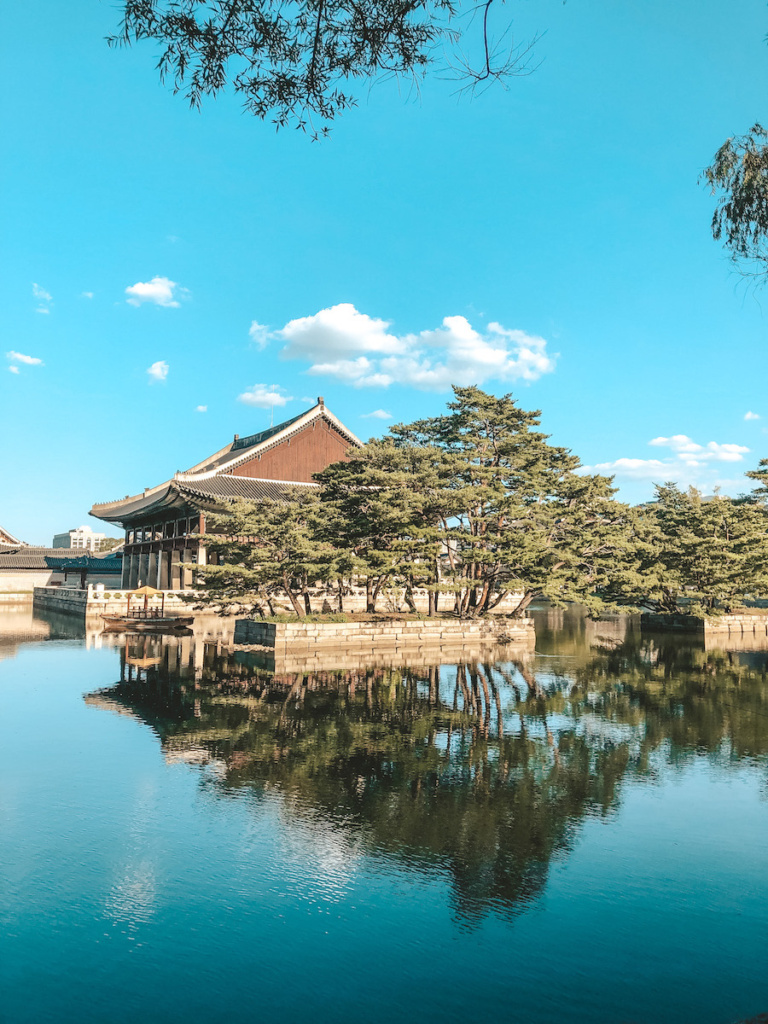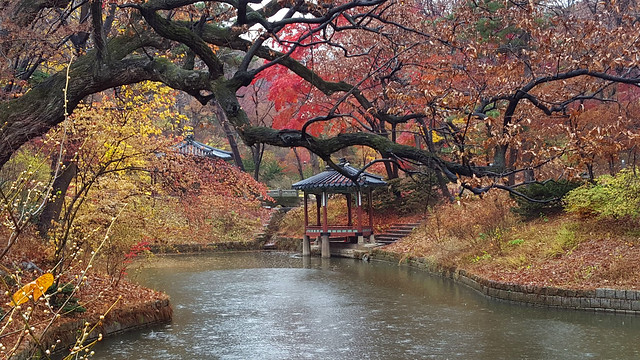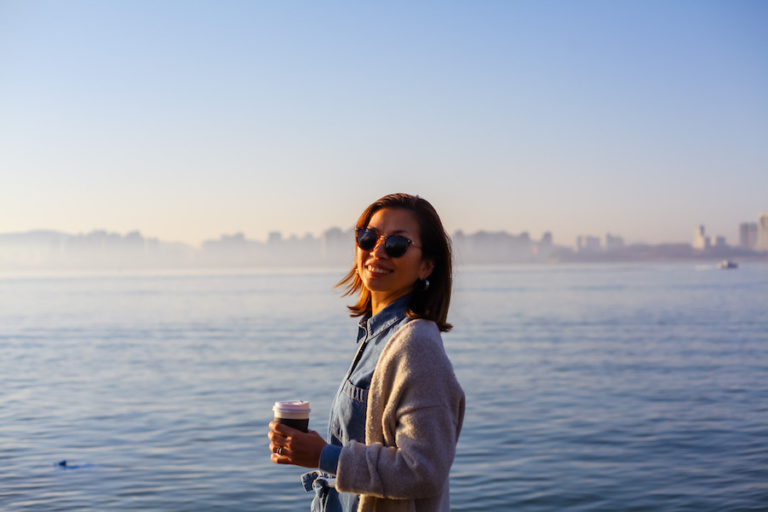GUIDE TO THE 5 GRAND PALACES IN SEOUL

Visiting the five grand palaces in Seoul is a fantastic way to immerse yourself in the rich history and cultural heritage of South Korea.
Each palace has its unique charm, architecture, and historical significance. Here’s a brief overview of what each palace offers:
Gyeongbokgung, Changdeokgung, Changgyeonggung, Deoksugung, and Gyeonghuigung. are the 5 Grand Palaces of Seoul.
This post is the perfect guide if you are visiting Seoul and intend to explore 1, a few, or all of the 5 Grand Palaces during your time in South Korea.
Highlights about the 5 Grand Palaces in Seoul:
– The 5 Grand Palaces in Seoul were originally built several hundred years ago.
– These palaces have similar architectures (which we will explain in the last part of this post) but each of them is unique and presents its own charm.
– These palaces are a great way to remember the triumphs and falls of the Kings during the Joseong Dynasty.
For each palace, we will provide more explanation about the history and interesting facts and figures. We hope that you will enjoy the read and that you will find it useful.
The 5 Grand Palaces in Seoul
1. Gyeongbokgung (경복궁) – the main palace
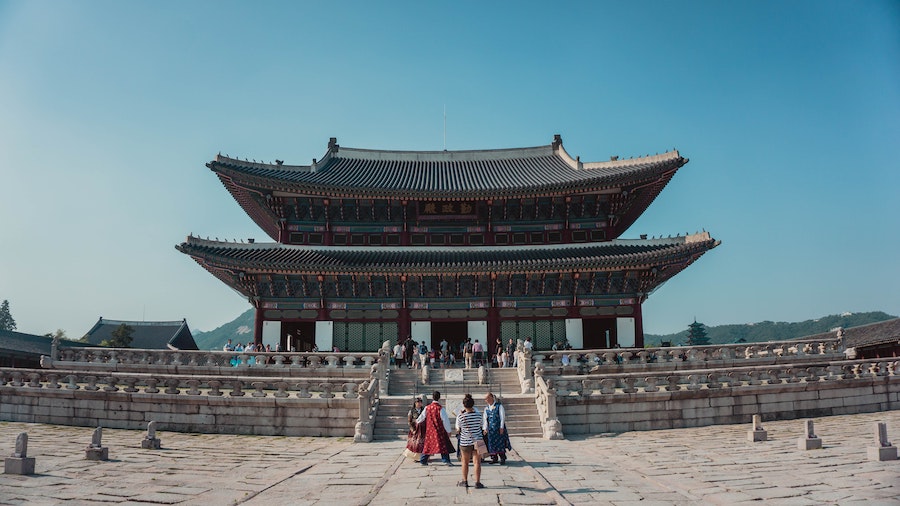
If your time is limited and you can only visit 1 palace, we recommend Gyeongbokgung. You can’t miss it, as its main gate is located at the end of Gwanghwamun (광화문) Square (the main square of Seoul). Gwanghwamun Square is like the Champs Elysees of Paris, in a way.
In Gyeongbokgung Royal Palace it is also there where you can experience the change of guards every day. More about this later…
The Gyeongbokgung Royal Palace was the first palace built during the Joseon Dynasty by King Taejo. Completed in 1395, the palace was continuously enlarged during the reigns of King Taejong and Sejong the Great. However, Gyeongbokgung was destroyed by a fire during Japan’s invasion of Korea (1592 ~ 1598). It was not until 1867 that the site was rebuilt to bring it back to life.
Unfortunately, during the Japanese occupation (1910-1945), 80% of the restored buildings were again dismantled, the main gate was removed, and a huge Japanese government building was constructed opposite the main palace area. Since 1990, the restoration of the palace has been underway. Finally, in 2010, the great main gate of the palace was able to regain its original place in front of Gwanghwamun Square. A magical sight, really!
You can check out our full post about Gyeongbokgung here.
What to see in Gyeongbokgung Palace?
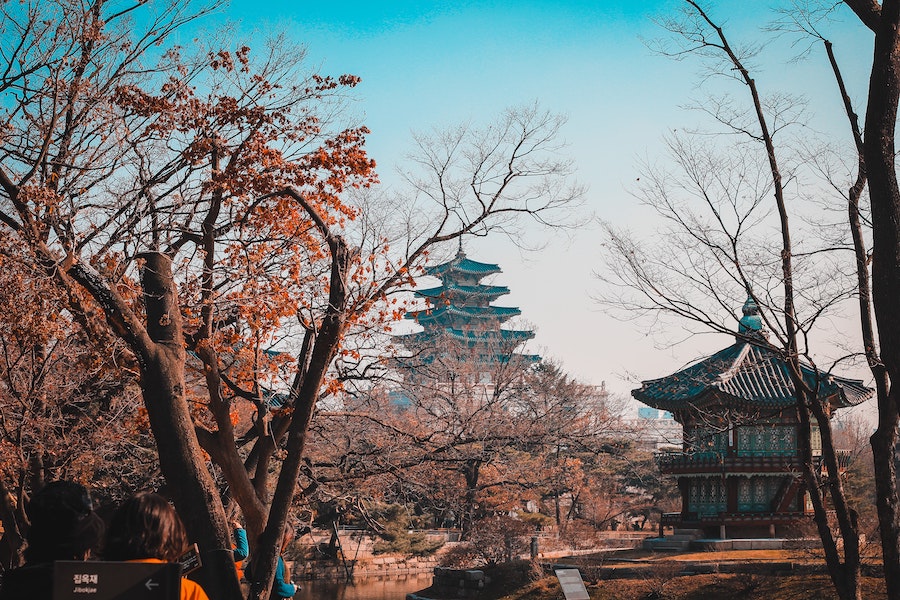
As you enter Gyeongbokgung Palace through Gwanghwamun Entrance, you can see the Geunjeongjeon Building, the center of the palace but also the largest wooden building in Korea. This building was the place of the king’s throne and housed important events related to the politics of the kingdom.
To the left of the geunjeongjeon building, visitors can admire the Gyeonghoeru pavilion which once served as a reception hall. This two-story pavilion was built over an artificial pond and is one of the structures not to be missed in the palace.
Out of the 5 Grand Palaces, Gyeongbokgung is considered the most beautiful of all. It serves as the backdrop for many movies, series, and TV shows.
Additionally, there are many other activities around Gyeongbokgung. Make sure to attend the change of guards every day at 10 a.m. and 2 p.m. inside the place. A similar ceremony takes place at the Gwanghwamun gate, at 11 a.m. and 1 p.m. It is the perfect opportunity to admire the parade of guards in traditional costumes full of bright colors.
There are 2 museums located inside the walls of the Palace. The National Folk Museum of Korea (국립민속박물관) displays historical artifacts that were used in the daily lives of Koreans in the past.
The 2nd Museum is The National Palace Museum of Korea. This museum showcases 500 years of history with roughly 45,000 artifacts from the Joseon Dynasty including texts and poems that were handwritten by kings of the past, robes worn by royalty, jewelry, and other items from the royal courts of Korea. Both museums are free.
Our opinion about Gyeongbokgung Palace

For us Gyeongbokgung Palace, felt a bit like the forbidden city in Beijing. A huge palace surrounded by tall walls at the center of the city.
Overall Gyeongbokgung Palace is very impressive from the entrance at Gwanghwamun Gate to the Gyeonghoeru pavilion and some of the museums, this is one of the most impressive places to visit in Seoul.
Although Gyeongbokgung Palace is supposed to be the main palace out of the 5 Grand Palaces in Seoul, it isn’t actually our favorite one… Keep reading to find out which one is our favorite 🙂
Important information
- Address: 161, Sajik-ro, Jongno-gu, Seoul (서울특별시 종로구 사직로 161)
- Opening hours: March-May, September-October 09:00-18:00 / June-August 09:00-18:30 / November-February 09:00-17:00 (closed Tuesdays)
- Admission: Adults 3,000 won / Children 1,500 won
- Hanbok rental: like for any palaces in Seoul, if you rent a Hanbok you can enter for free. You can rent a Hanbok with a discount here.
- Website: www.royalpalace.go.kr
- National Palace Museum: here
- National Folk Museum of Korea: here
- Full post: here
How to get there?
Walk approx. 4 min from Gyeongbokgung Station (Seoul Subway Line 3), Exit 5
2. Changgyeonggung (창경궁) the most romantic one

Changgyeonggung palace wasn’t built during the Joseon dynasty but during the Goryeo dynasty. Indeed the site of this palace was used as early as 1104 by King Sukjong. This is why this palace has a special feature. Its throne room faces east, not south as it would be during the Joseon dynasty.
The Myeongjeongjeon Pavilion (명 졍전) is now the oldest throne room in South Korea. It has been designated a national treasure.
The founder of the Joseon dynasty, King Taejo, decides two years after founding the dynasty to make Seoul the capital of the kingdom. While waiting for the construction of the Gyeongbuk Palace to be completed, the king decided to stay at the location of the present Changgyeongung Palace.
In 1418, his son, King Sejong, built Changgyeongung Palace for his father who had just abdicated in his favor. In 1484, King Seongjong (1469-1494) extended the Palace, and this building was intended to accommodate King Sejo’s widows. It was then that he took the name of Changgyeongung.
However, in 1592, the Japanese invasion did not spare this Palace either and it was completely burnt and then rebuilt in 1616. But it was once again destroyed in an accidental fire in 1830, most of the buildings were destroyed, only the central building, the Myeongjeongjeon, remained. It was again rebuilt identically in 1834.
During the Japanese occupation, the palace was transformed into a museum, zoo, and botanical garden, and in 1911 it lost its title and was renamed Changgyeongwon, in other words, Changgyeong gardens (in the word Changgyeonggung, the syllable gung means “palace”).
From 1983 to 1986 the palace was completely restored, the zoo moved and Changgyeong regained its status as a palace and its name: Changgyeonggung.
What to see in Changgyeonggung?

Changgyeonggung is not as big as the other palace and less touristy, but it is actually our favorite one! We visited the Palace during spring to see the beautiful cherry blossoms.
This palace is different to the others as there is a big space devoted to the daily life of the family which is much larger than the space devoted to political affairs. The site thus contains many more personal stories about the royal family, love and hatred between the king and the prince or even the tensions between the queen and the servants of the court.
First visit Honghwamun (홍화문) the meeting place between the king and the people. This is the main entrance gate. Then head to Myeongjeongmun gate (명 정문) after crossing the Okchongyo Bridge (옥천교), After passing through the two doors, enter the courtyard and you can see the oldest throne room in Korea: Myeongjeongjeon (명정전).
During your stroll, you might come across the Sungmundang building (숭문 당): it was mainly used as a study room by the king and it is also a place where he discussed political affairs with his high officials.
The best part of Changgyeonggung:


Now that you visited some of the main buildings, it is time to visit the best part of this Palace.
Climb the hill behind the buildings of the Palace and enjoy the gorgeous view of Changgyeonggung. After reaching the hill by the stairs continue your visit north through the forest.
As you continue your walk, you can discover a large and beautiful pond, called Chundangji. Originally, the large pond was a place where there was a rice field maintained by kings. However, in 1909, the Japanese built a pond there. Do not hesitate to take a break and sit on the benches near the pond and think about how the kings lived during their era.
After taking a rest at the pond, continue your visit to Daeonsil (대 온실): a greenhouse within Changgyeonggung Palace. In 1909, the Japanese also built a botanical garden within the palace. Daeonsil has undergone restoration work and reopened to the public in November 2017. You can discover several species and varieties of plants.
Our opinion on Changgyeonggung Palace

Changgyeonggung Palace is our favorite Palace in Seoul. On our first trip, it was the first palace we visited and we both kept fond memories of our visit. Compared for example to Gyeongbokgung, the palace has fewer visitors, so it is always more pleasant to walk around. In addition, there is a very nice walking trail which is part of the palace.
If you have any questions about Changgyeonggung, don’t hesitate to ask us! And for people who have visited the palace before, let us know about your experience in the comments!
The other good part about Changgyeonggung Palace, is that it is linked with the 3rd Grand Palace called Changdeokgung (창덕궁). You will need to pay an extra fee though.
Check out our full post on Changgyeonggun here
Important information
- Address: 185, Changgyeonggung-ro, Jongno-gu, Seoul (서울특별시 종로구 창경궁로 185)
- Opening hours: 09:00-21:00
- Admission: Adults 1,000 won / Children 500 wo
- Website: cgg.cha.go.kr
How to get there
Walk approx. 15 min from Hyehwa Station (Seoul Subway Line 4), Exit 4
3. Changdeokgung (창덕궁) the one with a secret garden

This Eastern Palace of Seoul or “Palace of Prosperity” was built during the Joseon dynasty from 1405 to 1412 during the reign of King Taejong. Its main gate is called Donwhamun (돈화문).
This palace was the favorite palace of many kings of the Joseon Dynasty, indeed it exhibits several characteristics specific to the Three Kingdoms of Korea that no longer appear in the architecture of Gyeongbokgung. For example, the buildings of Changdeokgung blends perfectly with the surrounding and original landscape. Other palaces would rather impose themselves on top of the landscape.
After its construction during the reign of Taejong, King Sejo had it enlarged by several hundred thousand square meters. However, it was destroyed like the other Palaces during the Japanese invasion in 1592 and then rebuilt in 1609 by Kings Sonjo and Kwanghaegun. In 1623 it was destroyed again by fire following the revolt against Kwanghaegun.
However, despite its successive reconstructions, it remained faithful to the initial design.
This palace was the seat of the court and the seat of government until 1872. The last king of Korea, Sunjong, lived there until his death in 1926.
What to see in Changdeokgung?
Surrounded by mountains and hills the site offers a beautiful harmony between nature and buildings and was once a privileged resort for the kings of Joseon and their subjects.
The main sight of Changdeokgung, is the Huwon Garden, also called Secret Garden. It is possible to freely visit the Injeongjeon and Nakseonjae pavilions within Changdeokgung Palace while the Huwon Garden can be visited by booking in advance with a guide. Reservations can be made online or directly on-site.
Additionally, visitors can enjoy a palace tour, titled ‘Changdeokgung by Moonlight’, during fall and spring from Donhwamun Gate. We highly recommend this tour by the way. It is absolutely magical to visit the temple at night.
Our opinion on Changdeokgung

Changdeokgung Palace feels like a peace haven in the heart of the busy Seoul. With its beautiful buildings and magnificent gardens.it is one of the 5 Grand Palaces of Seoul. This palace entered the UNESCO World Heritage List in 1997.
Since Changdeokgung and Changgyeonggung Palace are connected through a gate inside the place, we recommend combining the visit of both Palaces on the same day. For a break, there is a cafe in Changdeokgung’s garden.
Important information
- Address: 99, Yulgok-ro, Jongno-gu, Seoul (서울특별시 종로구 율곡로 99)
- Opening hours: ebruary-May, September-October 09:00-18:00 / June-August 09:00-18:30 / November-January 09:00-17:30 (*Closed Mondays)
- Admission: Adults 3,000 won / Children 1,500 won
- Secret Garden (Huwon Tour): Huwon tour: Adults & senior citizens 5,000won / Children 2,500 won
- Hanbok Rental: here
- Website: www.cdg.go.kr
How to get there
Walk approx. 5 min from Anguk Station (Seoul Subway Line 3), Exit 3
Read the full post about Changdeokgung here.
4. Deoksugung (덕수궁) the most westernized

Originally called Gyeongungung, Deoksugung Palace was the second most used palace by kings during the Joseon dynasty. The palace was first used as a temporary palace by the 14th King of Joseon (Seonjo) during Japan’s invasion of Korea.
It was not until the reign of the 26th King of Joseon (King Gojong) that the palace became a royal palace. The palace changed its name following the dismissal of King Gojong for the throne of Sunjong, the last king of the Joseon dynasty.
Like the other four royal palaces of the Joseon dynasty, Deoksugung Palace was heavily and intentionally destroyed during the Japanese occupation, currently only a third of the buildings remain as compared to the period prior to the Japanese occupation.
Less imposing in size than the first three palaces, it is the smallest of Seoul’s five palaces. However, Deoksugung has the significant advantage of being able to be visited in the evening. There is surely nothing more beautiful than seeing these buildings from ancient times illuminated.
Located right next to Ciy Hall, Deoksugung Palace has the distinction of having both typical buildings from the Joseon era and structures dating from the first half of the 20th century, in a European style.
What to see in Deoksugung?

The Jeonggwanheon Pavilion owes its form to an architect of Russian origin and offers a subtle blend of Western and Korean style. Its name means ‘a space to silently contemplate the world’. This is a place frequented by the king when he was concerned for the safety of his kingdom.
Seokjojeon is the most remarkable western-style building constructed during the Joseon dynasty in 1910. It consists of a basement floor which was used for court valets, a ground floor for official business, and a second floor for the daily life of the royal family. It is now possible to freely visit the underground space, while the upper floors can be visited by reservation only (on the internet).
The changing of the guard ceremony takes place every day at 10 a.m., 2 p.m. and 3:30 p.m., in front of the Deoksugung (Daehanmun) Great Gate.
It is also possible to participate in a guided tour. There are two a day, one at 10:45 am and the other at 1:30 pm.
Our opinion on Deoksugung

Deoksugung is not as impressive as the other ones. However, we really loved visiting the Palace at night. Right in the middle of the Illuminated Palace, your will be surrounding by tall buildings from the citiy outside the gate. The contrast is absolutely stunning. We recommend a visit to Deoksugung at night. After the visit of the Palace, turn right when going out. There is a very charming street along the wall of Deoksugung. This place if very popular for instragrammers.
Check out our full post about Deoksugung Palace here.
Important information
- Address:99, Sejong-daero, Jung-gu, Seoul (서울특별시 중구 세종대로 99)
- Opening hours: 09:00-21:00 (*Closed Mondays)
- Admission: Adults 1,000 won / Children 500 won
- Website: www.deoksugung.go.kr
How to get there
Walk approx. 5 min from City Hall Station (Seoul Subway Line 1, 2), Exit 1
5. Gyeonghuigung (경희궁), the youngest

Fifth and final, Gyeonghuigung Palace is the most recent of Seoul Grand Palaces. Built at the very beginning of the 17th century as the king’s second home, the Japanese used the place for a school, before eventually destroying it completely in the 20th century. The current construction is therefore not the original one, but a more modern and smaller one. It did not reopen its doors to the public until 2002.
Attached to Gyeonghuigung Palace is the Seoul Museum of History. Opened for the first time in 1985, it allows you to trace the entire history of the construction of the capital to the present day. The visit is free.
What to see in Gyeonghuigung?
After passing through the Sungjeongmun Gate (정문 정문), rebuilt in 1988, one faces directly the main palace building called Sungjeongjeon. This is the most important and grand hall in Gyeonghuigung Palace.
Sungjeongmun houses the king’s throne. Indeed, it is here that the king met the high officials. In addition, this is where official ceremonies were held.
During Japanese colonization, Sungjeongjeon was sold and then moved. Nowadays, it is located at Dongguk University and is used as a Buddhist temple under the name Jeonggakwon (정각원). This building could not be moved back into the palace because it was too complicated to do. So if you want to see the original building, you will have to go to the university. The building we see now at the palace is a reconstruction from 1985.
Then head to Jajeongjeon (자 정전). It was a personal space for the king and it was also in this building that the king discussed the affairs of the country with his subjects. It also served as a venue for academic competitions.
Finally, Heungwamun (흥화문) is the main gate of Gyeonghuigung Palace. During Japanese colonization, this door was first moved to a temple and later it was used as the main entrance to the Silla Hotel. However, in 1988 the gate was moved back into the palace.
Our opinion on Gyeonghuigung
It was a very nice visit, where we stayed a little less than 1 hour. We really like this palace. First of all for its beautiful architecture and especially for its peaceful aspect. We also recommend a visit to the Seoul History Museum which is right next to the palace. Also, out of the 5 palaces, this one is completely free.
Important information
- Address:서울 특별시 종로구 신문 로 2 가 1-2
- Opening hours: 9: 00-18: 00. Weekends and holidays: 10: 00-18: 00.
- Admission: Free
How to get there
Getting there by subway: Stop at Seodaemun station (line 5) and take exit 4. Then walk straight for about 8 minutes. You can also stop at Gwanghwamun station (line 5) and take exit 7. You will then have to walk a bit more.
Other useful information for visiting Seoul Palaces

The Pass
To make the most of these five palaces, the city of Seoul has implemented a pass. This is a small notebook with tear-off coupons. To purchase it, simply go to the cash desk at one of these five locations and request a Combination ticket for palaces. It is 10,000 won (5,000 won for adolescent and child fare). Which is cheaper than paying for each visit. This pass is valid for three months.
Guided tour
Another tip: visit the Seoul Palace with a cultural guide. Indeed, nothing better than visiting a palace with a specialist. These tours are free and available in several languages (Korean, English, Chinese, Japanese). Just ask the front desk or check online for free tours.
Klook.comNight visit
Gyeongbokgung, Changdeokgung and Changgyeonggung Palaces offer night tours every year until 10 p.m. Check their respective website for more information.
Rent a Hanbok
You get a free entrance if you wear a Hanbok when entering Seoul Palaces. Besides skipping the admission fee, renting a Hanbok is a really fun thing to do in Seoul. Take plenty of memorable pictures with your hanbok. You can book them here and collect them in the shop before your visit.
Klook.comAll you need to know about the architecture of Seoul 5 Grand Palaces
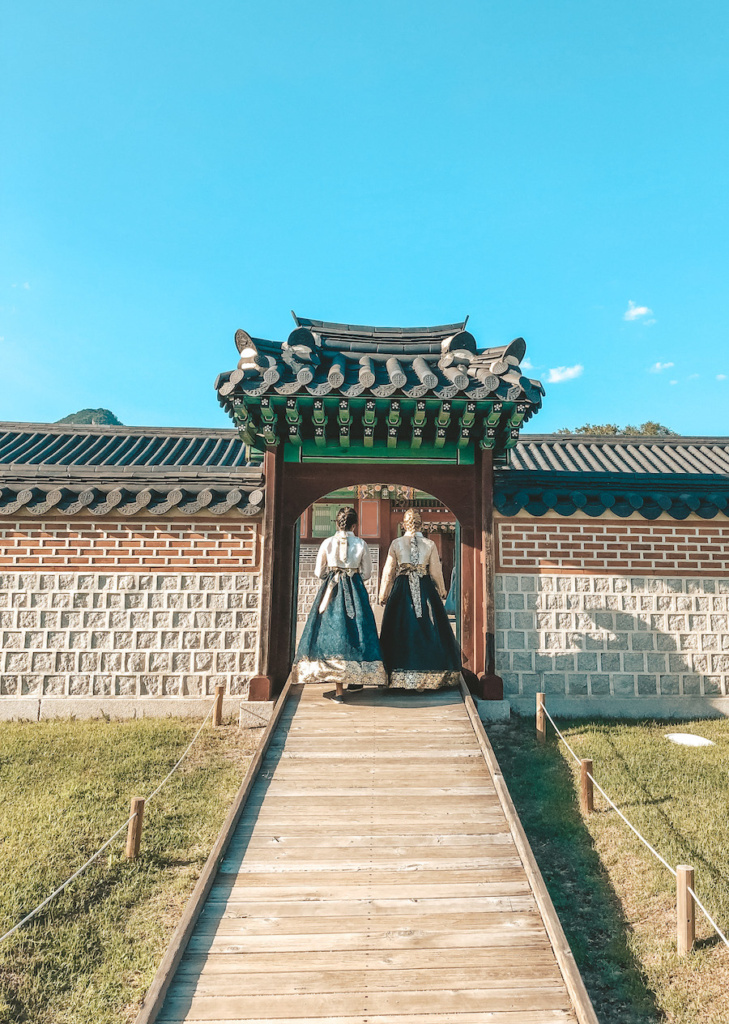
These palaces are built according to an identical scheme:
Naejeon (내전)
Naejeon is a space dedicated to the life of the royal family: composed of the king’s private room, the jajeongjeon (자 정전), a main sungjeongjeon (숭정전), and the taeryeongjeon (태령 전). A junggung space (중궁) corresponding to the Queen’s residence. Donggung space (동궁) which is the residence of the servants
Woejeon (외전)
A woejeon is the space for official business. The woejeon consists of a main jeongjeon building (정전), an office for the peonjeon king (펀전), a building for the affairs of the king’s subjects, etc. In this space is also the throne room, geunjeongjeon (근정전) where the king granted official audiences and welcomed foreign ambassadors and emissaries. The sajeongjeon hall (사정전) was the seat of the royal executive.
The pumgyeseok (품계석)
During the Joseon dynasty, the government had 18 different highly hierarchical ranks. Therefore, in front of the jeongjeon buildings, one can find two rows of standing stones, called pumgyeseok (품계석) indicating where court officials stood, according to their rank, during events at the palace. Two royal guards were seated to the right and left of the jeongjeon building.
The dancheong (단청)
The paintings that you will see frequently are the dancheong (단청). These are the patterns depicted on the wood of buildings, in five colors (blue, red, yellow, white, and black). Their function was to protect the building against insects and squalls of rain. While patterns may have a significantly different meaning from palace to palace, they generally symbolize protection against spirits and fires.
And now you know everything about the structure of Seoul 5 Grand Palaces.
In conclusion about Seoul Grand Palaces

So do you know how to pronounce any of the Seoul 5 Grand Palaces’ names yet? No?? Don’t worry, even after 3 years we still struggle to pronounce any of the palaces’ names. Being lost in translation is part of the fun when living in Korea.
It is complicated to discover them all in one stay. We recommend that you choose one or two from the ones that interest you the most.
If your time is really limited, then our recommendation is to pick Gyeongbokgung. If you do have a bit more time then combining Changgyeonggung and Changdeokgung would be our recommendation, as those 2 are our favorite ones.
Finally, be aware that if you wear a hanbok at the time of your visit, all the palaces in Seoul will be free!
We lived in Seoul for 3 years and loved exploring all these beautiful places in Korea. There are many posts about Korea in this blog, you can find them all here.
HAPPY TRAVEL!
Links to related articles
- CHANGGYEONGGUNG our favorite palace in Seoul
- GYEONGBOKGUNG PALACE: the biggest of all
- DEOKSUGUNG PALACE
- BEST DAY TRIPS FROM SEOUL: escape the city for a day
- AWESOME ADVENTURES near Seoul
- GANGNEUNG: a gorgeous place on the east coast of Korea
- SOUTH KOREA: some of the most amazing things to do in South Korea
- JEJU: the best island escape from Seoul

